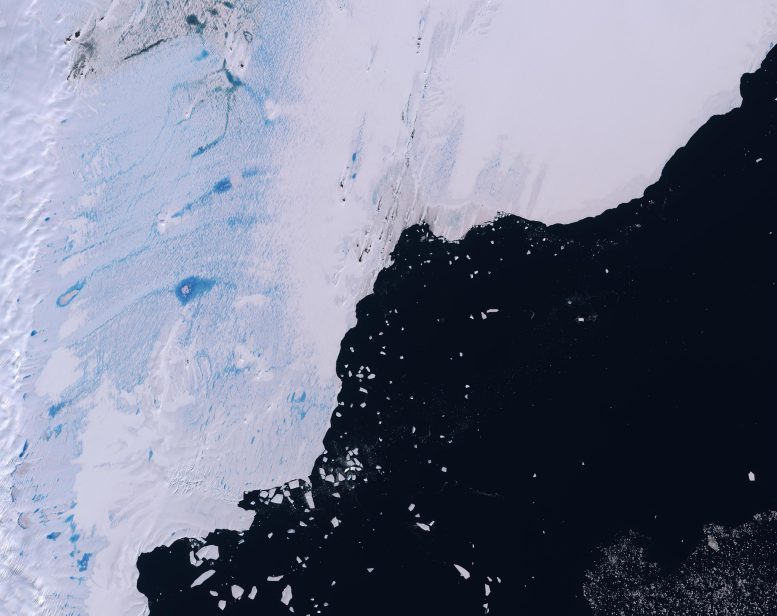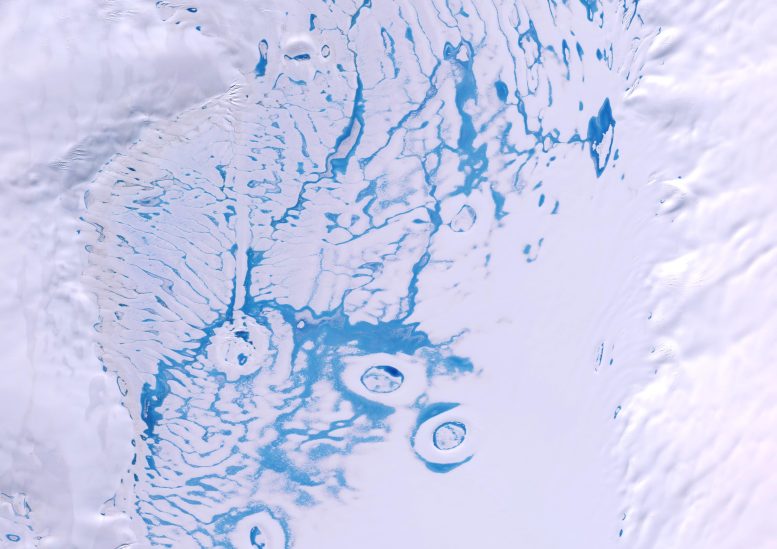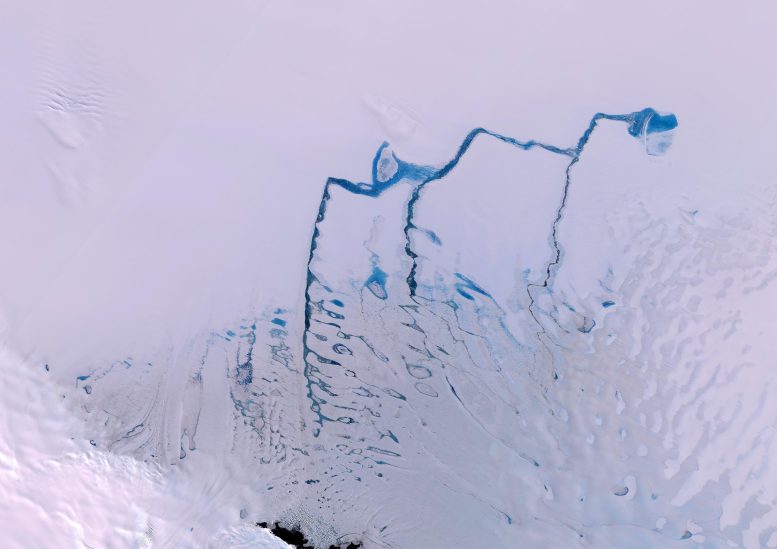
Pooled meltwater and slush on the Tracy Tremenchus Ice Shelf, which flows into the Southern Ocean. Credit: Contains modified Copernicus Sentinel data [2018], processed by Rebecca Dell
This finding is significant as slush absorbs more solar heat compared to ice and snow, potentially leading to increased ice shelf instability and accelerated sea level rise. This slush is often overlooked in climate models, which may underestimate its impact on ice shelf fracture and melting processes.
Understanding Slush’s Role in Antarctic Meltwater
Slush – water-soaked snow – makes up more than half of all meltwater on the Antarctic ice shelves during the height of summer, yet is poorly accounted for in regional climate models.
Researchers led by the University of Cambridge used artificial intelligence techniques to map slush on Antarctic ice shelves, and found that 57% of all meltwater is held in the form of slush, with the remaining amount in surface ponds and lakes.

Pooled meltwater and slush on the Bach Ice Shelf. Credit: Contains modified Copernicus Sentinel data [2023], processed by Rebecca Dell
The researchers also found that slush and pooled meltwater leads to 2.8 times more meltwater formation than predicted by standard climate models, since it absorbs more heat from the sun than ice or snow. The results, reported today (June 27) in the journal Nature Geoscience, could have profound implications for ice shelf stability and sea level rise.
Advancements in Mapping Meltwater and Slush
Each summer as the weather warms, water pools on the surfaces of Antarctica’s floating ice shelves. Previous research has shown that surface meltwater lakes can contribute to ice shelf fracture and collapse, as the weight of the water can cause the ice to bend or break. However, the role of slush in ice shelf stability is more difficult to determine.
“We can use satellite imagery to map meltwater lakes across much of Antarctica, but it’s hard to map slush, because it looks like other things, such as shadows from clouds, when viewed from a satellite,” said lead author Dr. Rebecca Dell from Cambridge’s Scott Polar Research Institute (SPRI). “But using machine learning techniques, we can go beyond what the human eye can see and get a clearer picture of how slush might be affecting ice in Antarctica.”

Pooled meltwater and slush on the Nivlisen Ice Shelf. Credit: Contains modified Copernicus Sentinel data [2020], processed by Rebecca Dell
“Machine learning allows us to use more information from the satellite, since it can work with more wavelengths of light than the human eye can see,” said Dell. “This allows us to determine what is and isn’t slush, and then we can train the machine learning model to quickly identify it across the whole continent.”
“We’re interested in learning how much slush is present during the Antarctic summer, and how it’s changed over time,” said co-author Professor Ian Willis, also from SPRI.
Implications for Climate Models
Using their machine learning model, the researchers found that in the peak of the Antarctic summer in January, over half (57%) of all meltwater on Antarctica’s ice shelves is held in slush, with the remaining 43% in meltwater lakes.
“This slush has never been mapped on a large scale across all of Antarctica’s large ice shelves, so over half of all surface meltwater has been ignored until now,” said Dell. “This is potentially significant for the hydrofracture process, where the weight of meltwater can create or enlarge fractures in the ice.”
Meltwater affects the stability of the floating ice shelves that fringe the Antarctic coastline. As the climate warms and melt rates in Antarctica increase, meltwater – whether in the form of lakes or slush – can get into cracks on the ice, causing the cracks to get bigger. This can cause fractures in the ice shelf, and could cause vulnerable ice shelves to collapse, which in turn would allow inland glacier ice to spill into the ocean and contribute to sea level rise.
“Since slush is more solid than meltwater, it won’t cause hydrofracture in the same way that water from a lake does, but it’s definitely something we need to consider when attempting to predict how or whether ice shelves will collapse,” said Willis.
In addition to the potential implications of slush on hydrofracture, it also has a large effect on melt rates. Since slush and lakes are less white than snow or ice, they absorb more heat from the sun, causing more snowmelt. This extra melt is currently unaccounted for in climate models, which may lead to underestimates in projections of ice sheet melting and ice shelf stability.
“I was surprised that this meltwater was so poorly accounted for in climate models,” said Dell. “Our job as scientists is to reduce uncertainty, so we always want to improve our models so they are as accurate as possible.”
Future Predictions
“In the future, it’s likely that places in Antarctica that currently don’t have any water or slush will start to change,” said Willis. “As the climate continues to warm, more melting will occur, which could have implications for ice stability and sea level rise.”
Reference: “Substantial contribution of slush to meltwater area across Antarctic ice shelves” by Rebecca L. Dell, Ian C. Willis, Neil S. Arnold, Alison F. Banwell and Sophie de Roda Husman, 27 June 2024, Nature Geoscience.
DOI: 10.1038/s41561-024-01466-6
The research was supported in part by the European Space Agency and the Natural Environment Research Council (NERC), part of UK Research and Innovation (UKRI). Rebecca Dell is a Fellow of Trinity Hall, Cambridge.









“Researchers … used artificial intelligence techniques to map slush on Antarctic ice shelves, and found that 57% of all meltwater is held in the form of slush, with the remaining amount in surface ponds and lakes.”
Are they asserting that the 57% figure is the volume of meltwater? If so, they don’t explain how they determined the depth of the slush. Optical methods can provide the area, but the depth and water saturation requires other information not readily available from Landsat imagery.
“…, the floating ice surrounding Antarctica which acts as a buttress against glacier ice from inland.”
What buttressing effect might be present is only going to be effective up stream of the grounding line. That is why wind is able to blow the shelf ice around.
“…, surface meltwater lakes can contribute to ice shelf fracture and collapse, as the weight of the water can cause the ice to bend or break.”
This needs further explanation. The meltwater doesn’t weigh any more than the original snow and ice.
“Since slush and lakes are less white than snow or ice, they absorb more heat from the sun, causing more snowmelt.”
One reads this claim frequently. Reality is more complex. The reflectivity of water, for glancing angles, is higher than for snow or ice. Therefore, the reflectivity varies with the time of day and season. This is normal behavior. When I was in Greenland in July 1966, I observed that the slush on the surface of the glacier was about a meter in depth. It was firm enough to support an Arctic fox, but I was reluctant to test it with my weight.
As is often the case, these press releases raise more questions than they answer.